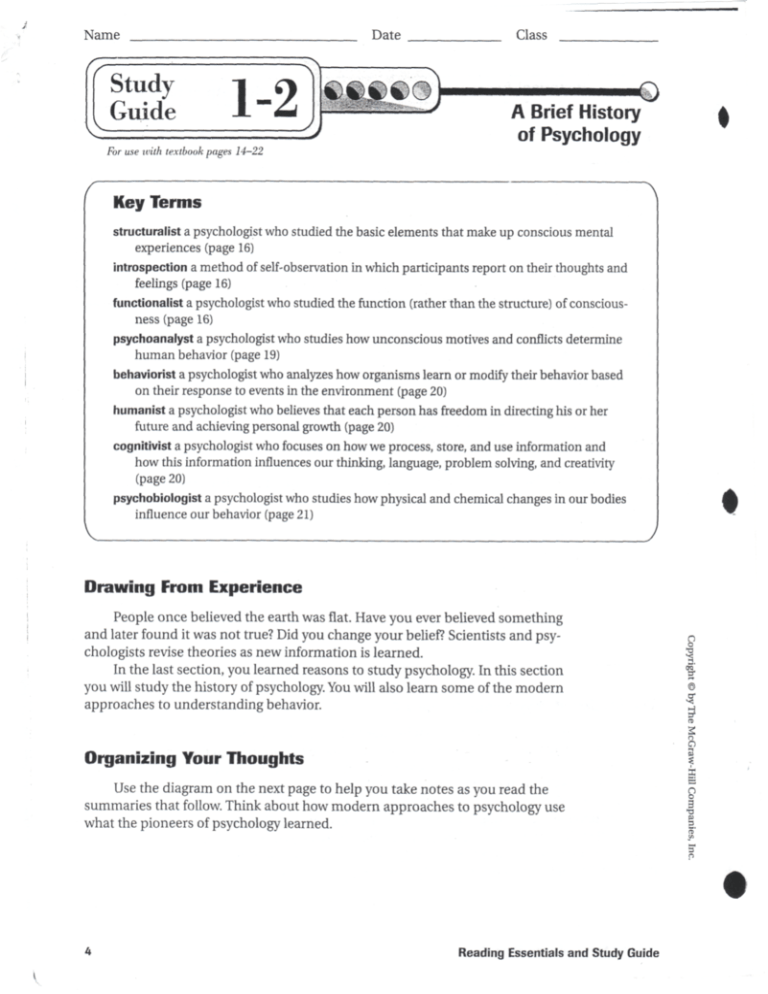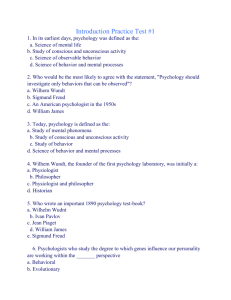Psychology 1.2 - Worksheet 1-2
advertisement

Name Study Guide Date 1-2 eg,®sgygy-..,.,.^/ e'gi) Class A Brief History of Psychology For use with textbook pages 14-22 Key Terms structuralist a psychologist who studied the basic elements that make up conscious mental experiences (page 16) introspection a method of self-observation in which participants report on their thoughts and feelings (page 16) functionalist a psychologist who studied the function (rather than the structure) of consciousness (page 16) psychoanalyst a psychologist who studies how unconscious motives and conflicts determine human behavior (page 19) behaviorist a psychologist who analyzes how organisms learn or modify their behavior based on their response to events in the environment (page 20) humanist a psychologist who believes that each person has freedom in directing his or her future and achieving personal growth (page 20) cognitivist a psychologist who focuses on how we process, store, and use information and how this information influences our thinking, language, problem solving, and creativity (page 20) psychobiologist a psychologist who studies how physical and chemical changes in our bodies influence our behavior (page 21) Drawing From Experience People once believed the earth was flat. Have you ever believed something and later found it was not true? Did you change your belief? Scientists and psychologists revise theories as new information is learned. In the last section, you learned reasons to study psychology. In this section you will study the history of psychology. You will also learn some of the modern approaches to understanding behavior. SS H o Organizing Your Thoughts Use the diagram on the next page to help you take notes as you read the summaries that follow. Think about how modern approaches to psychology use what the pioneers of psychology learned. n I n Reading Essentials and Study Guide Date Name i Historical Approaches Class Modern Approaches 1. 5. 2. 6. 3. 7. 4. 8. 9. 10. Read to Learn Introduction (page 14) Phrenology is the study of head shape and bumps on the skull. Phrenology is not really a science. It has been disproved. Phrenology, however, did help scientists recognize that the brain is responsible for our behavior. 11. If phrenology had been proven to be accurate, how might it have been used to predict human behavior? D. O O £ I o s © The Origins of Psychology (page 15) Psychology has its roots in philosophy. The early Greeks were the first to study human behavior. They believed the heart was more important than the mind. Scientists, such as astronomers and physicists, began using formal scientific methods during the Renaissance. Their discoveries changed the way we look at the world. One popular idea during the seventeenth century was dualism. It was the concept that the mind and body are separate. Rene Descartes disagreed. He believed that the mind controlled the body. He assumed that one influenced the other. Psychologists today still study how the mind and body work together. Reading Essentials and Study Guide Name _____ Date Class 12. Why do you think the Greeks thought the heart was more important than the mind? Historical Approaches (page 15) Not all psychologists agree. When psychology was a young science, different schools of psychology arose. Each offered its own explanation of human behavior. The structuralists studied the basic elements of human experience. Wilhelm Wundt founded this school. He used introspection to gather information. Introspection uses self-observation. From the observed behaviors, Wundt tried to map the processes of thought. William James is considered the father of American psychology. He believed that everything we think and do helps humans survive. His school, the functionalists, studied how animals and people adapt to their environments. Sir Francis Gallon studied how heredity affects behavior. Heredity consists of the traits that we receive biologically from our parents. Galton studied traits by tracing ancestry. Psychologists today still study how heredity influences behavior. The word Gestaltis German. It means "whole pattern." Gestalt psychology examines whole patterns. For example, when you look at a chair, you see it as the sum of its parts. You do not see it as four legs, seat, and back. You see the whole chair. Gestalt psychology still influences the study of sensation and perception. 13. Focus for one minute on exactly what you are doing. Write a complete description of your thought processes. nc t± 9 Contemporary Approaches (page 17) Many of the ideas from historical approaches to psychology are still used today. Sigmund Freud studied the unconscious mind. He believed that much of our behavior results from conflicts we face. He encouraged his patients to use free association to help them to resolve their conflicts. He encouraged people to analyze their dreams. Freud was a psychoanalyst. His job was to listen and be 6 Reading Essentials and Study Guide Pf Name Date Class objective. He encouraged patients to work through their own problems. Most of Freud's research is based on case studies. Ivan Pavlov examined how behaviors could be conditioned. He rang a tuning fork each time he fed a dog. Soon the dog began salivating whenever it heard the tuning fork. Pavlov trained the dog to respond to the tuning fork. Researchers have shown that conditioning works with humans also. John B. Watson believed psychology should only study observable behaviors. He was a behaviorist. He believed that all behavior was the result of conditioning. Another behaviorist, B.F. Skinner, studied reinforcement. He believed that behavior is shaped by the rewards that we receive. Behavior that is rewarded will be repeated. Humanists, like Abraham Maslow and Carl Rogers, disagree with behaviorists. They believe that human behavior is not controlled by outside events like rewards. They see behavior as internal and self-directed. They seek to find ways for each person to reach his or her full potential. Cognitivists, like Jean Piaget and Noam Chomsky, focus on thinking, problem solving, and creativity. Their research has been directed toward understanding how we store, process, and use information. Advances in technology have opened new avenues of research for psychologists. Psychobiologists use PET and CAT scans to study the brain. They link genetic factors to human behavior. They have been able to see what parts of the brain are active during sleep. They are demonstrating how the mind and body work together. A new approach to psychology is called sociocultural psychology. It examines how cultural and ethnic similarities and differences influence behavior. For example, what you say when you sneeze is influenced by your culture. In some cultures, sneezes are good omens. In others, they may be viewed as bad omens. If your culture believed a sneeze was a bad omen, you would try hard not to sneeze. The United States has large immigrant populations. Each immigrant group has its own culture. Conflicts can arise when one culture holds different views from another culture. Sociocultural psychologists look for ways to resolve and minimize these conflicts. 0 .<§ I 14. How can social psychologists use other psychological approaches to help resolve cultural or ethnic conflicts? o 3 Reading Essentials and Study Guide





